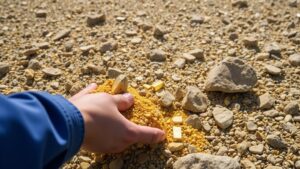How to Identify Silver Minerals in Epithermal Deposits
How to Identify Silver Minerals in Epithermal Deposits
Understanding how to identify silver minerals in epithermal deposits is crucial for mining and geological exploration. Epithermal deposits are formed at relatively shallow depths and are characterized by their association with volcanic activity and hydrothermal processes. Such deposits can be rich in valuable metals, particularly silver. This article provides a comprehensive guide on identifying these minerals, including methodologies, characteristics, and the significance of each during exploration.
Understanding Epithermal Deposits
Epithermal deposits typically occur in volcanic regions and are formed by hydrothermal fluids that rise through the Earth’s crust. These fluids deposit minerals as they cool and react with surrounding rocks. The temperature at which these deposits form usually ranges from about 50°C to 300°C. two main types of epithermal deposits include:
- Low-sulfidation deposits
- High-sulfidation deposits
Silver often occurs within these deposits alongside other metals such as gold, lead, and zinc, making exploration efforts imperative for maximizing recovery.
Characteristics of Silver Minerals
To effectively identify silver minerals in epithermal deposits, it is essential to be familiar with their physical and chemical characteristics. Silver can occur in various forms, including:
- Native silver: A metal that appears as shiny, metallic grains or nuggets.
- Argentite: A silver sulfide mineral, typically black or dark gray in color.
- Chalcocite: A copper sulfide mineral that can contain significant silver.
- Silver-bearing galena: A lead sulfide mineral that sometimes contains silver in its structure.
Identification can be performed through visual inspection, color, luster, and hardness tests, as well as through advanced techniques such as X-ray diffraction (XRD) and scanning electron microscopy (SEM).
Field Identification Techniques
Field identification of silver minerals typically combines several techniques. Here are some essential methods:
- Visual Inspection: Look for distinct colors and luster characteristic of silver minerals. For example, native silver appears lustrous, while argentite displays a duller appearance.
- Mineralogical Analysis: Collection of samples for laboratory analysis can help determine mineral composition accurately. Techniques include XRD, which identifies crystalline structures.
- Geochemical Assaying: This method measures the concentration of silver within a sample using techniques like fire assay or inductively coupled plasma (ICP) methods.
For example, geochemical assays typically yield precise numerical values of silver content, thus supporting field observations with quantitative data.
Real-World Applications
The identification of silver minerals in epithermal deposits has extensive applications in mining and resource extraction. For example, the Penasquito mine in Mexico is one of the largest epithermal deposits where silver mining operations are conducted. Proper identification methods have contributed to successful mining ventures and have allowed for the efficient processing of ore.
Challenges in Identification
While identifying silver minerals can be straightforward, there can be challenges. Some of these may include:
- Sample Contamination: Field samples may get contaminated, which can lead to inaccurate identification.
- Similar Appearance: Some minerals may have similar physical characteristics, making it difficult to differentiate them without precise techniques.
Preventing contamination can involve following strict sampling protocols and continuously calibrating analytical equipment used in laboratories.
Actionable Takeaways
Identifying silver minerals within epithermal deposits is a multi-faceted process requiring a blend of observational and analytical skills. Here are key points to remember:
- Familiarize yourself with the physical characteristics of various silver minerals.
- Employ a combination of field techniques and laboratory analyses for accurate identification.
- Stay informed about advances in mineralogical studies and analytics for enhanced results.
By adhering to these practices, geologists and mineral resource specialists can foster successful exploration and contribute to the sustainable management of mineral resources in the mining industry.



